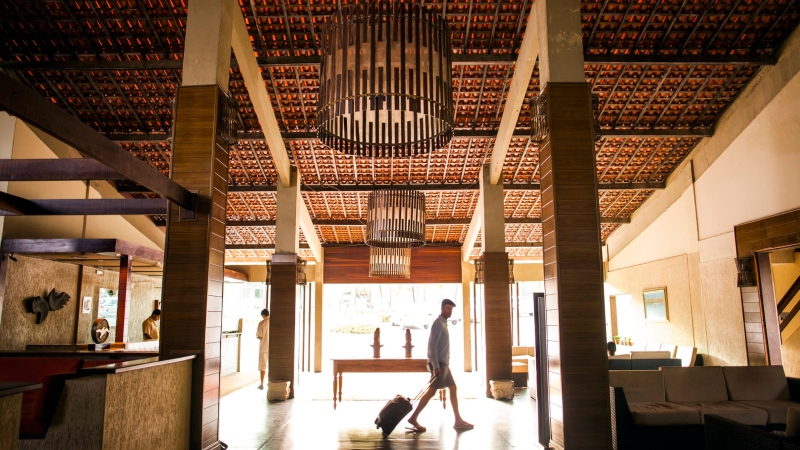Hotel market segmentation is the process of grouping hotel guests into categories based on their booking patterns and travel habits. By segmenting hotel guests into market groups, hoteliers are able to identify where their business is coming from, spot new business in the area, and drive hotel revenue.
In this guide, we dig into the details of hotel market segmentation and how it works. We take a look at major hotel market segments, how hotels segment their markets, and the benefits of using hotel market segmentation to inform strategy.
Unlock the benefits of hotel market segmentation
Through market segmentation, hotel professionals are able to group travellers based on their reason for travel and hotel preferences, as well as when and where guests book.
Major hotel market segments
There are three primary hotel market segments: transient, corporate, and MICE. Each of the three major segments can be broken down into smaller, more specific market segments that further detail customer travel patterns.
Below, we’ve detailed the major market segments, both the primary three and a handful of other smaller segments, that hoteliers track to identify guest booking trends and travel habits.
● Transient: Transient travellers are guests who book at non-group and non-negotiated rates. Transient travellers typically book short stays within a relatively small booking window, and they may be travelling for business or leisure purposes. They may book a few days in advance, be walk-in guests, or book same-day online reservations.
● Corporate Negotiated Rates (CNRs): CNRs represent business travellers who book at specified rates previously agreed upon by the hotel and travel buyers or planners for a national business. Hotels receive RFPs for corporate accounts from lead sourcing platforms, global distribution systems (GDSs), or as the result of brand agreements.
● Local Negotiated Rates (LNRs): Similar to CNRs, locally negotiated rates are established between the hotel sales or revenue manager and local businesses nearby. Hotels often locate LNRs by uncovering new business travel needs in their area. Local businesses may require hotel accommodations for annual meetings, conferences, audits, union negotiations, expansions, or other business activities that include out-of-town visitors.
● MICE: One of the largest hotel market segments, MICE business refers to a block of rooms, typically booked and coordinated by a primary MICE contact, reserved at a discounted rate. Hotels can book these travellers by receiving RFPs, contracting with travel agencies, and taking requests for MICE blocks directly. Youth sports, wedding blocks, and local events can drum up high MICE demand.
● Discount: While many hotel rate plans designate a discount off of the best available rate, the discount market segment typically refers to AAA discounts, credit card rewards, traveller programmes, online or mobile promotions, flash sales, online brand campaigns, holiday packages rates, and similar offers.
● Wholesale: Many large hotels offer bulk room blocks to tour operators or entertainment booking agents who require a significant number of hotel rooms at a discounted rate. A market segment that falls into the group business category, wholesale business includes tours, symphonies, travelling musicals, bands, and production crews.
● Other: A hotel’s “other” category may include discounted brand or employee rates, complimentary rooms, or other industry rates. Some hoteliers choose to lump these outlier rate plans inside their discount market segment, but doing so could lead to a lower-than-accurate representation of the segment’s revenue per available room or average daily rate.
Working with hotel market segmentation
Hotel professionals use hotel market segmentation to better reach specific travellers with personalised and relevant marketing materials, targeted pricing strategies, and customer-centric services. In fact, many hotels create successful pricing strategies by placing their most relevant market segments at the centre of their plans and then building on a base of their best guests.
Follow these tips to identify your hotel’s most beneficial market segments and put segmentation to use:
1. Use accurate data
Hotel market segmentation relies on receiving accurate travel reporting and analytic guest data. A high-quality revenue management system can help ensure that hotels receive accurate business intelligence, up-to-date rate plan analysis, and comprehensive revenue reporting.
2. Get to know your guests
Which hotel guests bring the most business to your property? Identify the types of hotel guests who regularly visit your hotel, noting their booking patterns, stay preferences, rate flexibility, and other important details.
Identify the following traits for the most profitable market segments at your hotel:
• Length of stay patterns
• Weekday vs weekend business
• Booking lead time
• Pricing sensitivity
• Cancellation percentages
• No-show ratios
• ADR and RevPAR per segment
Further detail individual market segments based on their reason for travel, such as business, leisure, or with a group.
Pro tip: Bleisure travel is on the rise as more business travellers seek to extend work trips for leisure purposes. Confirm if bleisure travel is a factor in your market and, if so, how much demand it’s producing.
Train front desk staff to get a reason for travel from every guest. Some guests won’t want to provide a reason; work with staff to identify opportunities to respond to guest objections, as well as realise when to stop pushing. Statements like, “We’d love to know your reason for travel to help ensure that we provide you the best service possible,” can go a long way.
3. Analyse booking channels
To further aid in identifying your hotel’s market segments, look at the booking method different travellers use. Channel segmentation helps hoteliers identify where their hotel guests are coming from and which booking channels are most commonly used for various traveller types.
Distribution channels frequently monitored by hoteliers include:
• Walk-ins
• Direct call
• Brand website
• OTAs
• GDS
• Metasearch
• Retail travel agents
• Voice reservations
Use hotel booking software that focuses on digitising reservations seamlessly.
4. Maximise rate level utilisation
The better you understand your hotel market segments, the more sophisticated your rate level management can be. By understanding different rate plans and the nuances of rate level utilisation, hotel revenue managers can maximise profits by limiting low-ADR rate plans, capping discounts, or applying selected blackout dates to specific rate plans or booking channels.
Pro tip: Look for a hotel channel manager that connects with your hotel PMS to facilitate ensure that your hotel’s live availability and rate level restrictions are reflected accurately via online distribution channels.
5. Break down hotel profits and expenses per market segment
Look at how much your hotel spends to acquire a new guest in each market segment (acquisition per guest), the ancillary revenue generated by a guest from each segment (how much non-room revenue is spent on goods and services), and how much total revenue each segment brings into the hotel.
Once you’ve accurately identified the base of your business, you are able to make rate and inventory changes that maximise the revenue potential of your hotel.
The benefits of using hotel market segmentation
What you do with your segmentation information is just as important as its accuracy. Once you have detailed data regarding the travel patterns and behaviors of your hotel’s best-performing segments, put it to good use!
● Uncover new business and demand opportunities in your market
Unearth new business opportunities in your market by uncovering local demand generators. Are businesses, universities, or developers expanding their territory in your area? Identify why new business is coming in, where it is going, and which market segments are contributing to new growth in your area.
Pro tip: Pinpointing growing market segments early can help hotel managers and sales directors reach new businesses before the competition.
● Dissect target markets for sales and marketing purposes
Advertise to various market segments based on traveler booking patterns, behaviours, and stay preferences. Create customer-centered services built for different traveller types. Advertise them to individual market segments through targeted and personalised hotel marketing campaigns, online ads, and promotional materials.
● Create different pricing strategies for different market segments
Maximise revenue by improving services and understanding the spending limits of different traveller types. Identify which of your travellers are the most service-sensitive and which are the most rate-sensitive. Offer flexible pricing options to your most rate-conscious travellers.
● Improve your forecasting to make better budget and rate decisions
By identifying and analysing the travel patterns of different market segments, hoteliers can better predict their behaviour in the future. Hotel market segmentation can be used to forecast demand surges, rate shifts, and budgetary fluctuations.
Hotel market segmentation tools & resources
From in-house reports to online analytics, there are a variety of tools and resources available that hotel professionals can use to improve their hotel market segmentation data.
● Hotel management systems
Take advantage of built-in reporting available in your hotel’s property management system (PMS), revenue management system (RMS), customer relationship management system (CRM), and sales system software. Track your hotel’s rate plan distribution each day to identify traveller trends.
Pro tip: Integrate your hotel’s property and revenue management systems to share rate level utilisation and rate plan information.
Review group pickup reports, corporate negotiated rate breakdowns, transient room night pickup reports, and other valuable data each month. Regularly reviewing relevant reporting makes it easier to spot hotel market segmentation trends and shift strategies to maximise hotel revenue.
● Google Analytics
Use Google Analytics to better understand the behaviours of your audience, as well as how your ideal demographic is interacting with your hotel’s website or brand.com page. Studying the online habits of your customers helps identify opportunities to maximise your exposure to online audience members.
Pro tip: Create a Google Business profile to utilise Google’s analytical services, boost your SEO results, as well as improve your SERP ranking (Search Engine Result Page).
● Competitive set data
To get a better picture of overall demand in your market, track business being booked by competing hotels and analyse the market segment breakdown of your comp set. Track leads that comp set hotels receive as well as their response patterns.
Is the comp set winning more group business than your hotel? Are you consistently losing corporate leads to the comp set?
Identify which market segments are underperforming at your hotel compared to similar properties in the market. Advertise your hotel to underperforming segments with targeted marketing campaigns, special offers, and promotional brand materials to help shift market share away from the competition.
● Hotel guests
Discussing travel needs directly with your guests is one of the best ways to get to know them better. By better understanding guests’ needs, preferences, and aversions, hotels are able to provide more specialised services.
Pro tip: If you want to know what your guests really want from a hotel, just ask them.
Ask guests to complete a survey about their travel habits and hotel service preferences after their stay. Email guests a post-checkout survey that inquires about their travel habits and area hotel preferences:
● Was your hotel their first option for accommodations in the area?
● If a competing hotel was preferred, what made the traveller ultimately choose your hotel?
● What did they most enjoy about their stay?
● Was there anything they wished was available during their stay but wasn’t?
● What would make your hotel the guest’s first choice on future trips to the area?
Encourage guests to provide feedback about their stay, posting on social media and leaving online reviews. Regularly reading and responding to guest reviews is a vital part of hotel market segmentation management. Categorise feedback by market segment to identify what different types of hotel guests care about most, as well as what the hotel can do to better appeal to different segments.
Not only do reviews provide honest feedback that guests may not feel comfortable communicating while on property, responding to online reviews helps hotels build credibility and trust with their customers.
It’s time to put your knowledge of hotel market segmentation to use
Now that you know what your hotel’s most relevant market segments are, it’s time to develop targeted marketing strategies for each segment. Next up, we’re reviewing the latest hotel marketing trends to help hotel managers, sales teams, and revenue directors create the most relevant, effective hotel advertising strategies for their target audiences.





